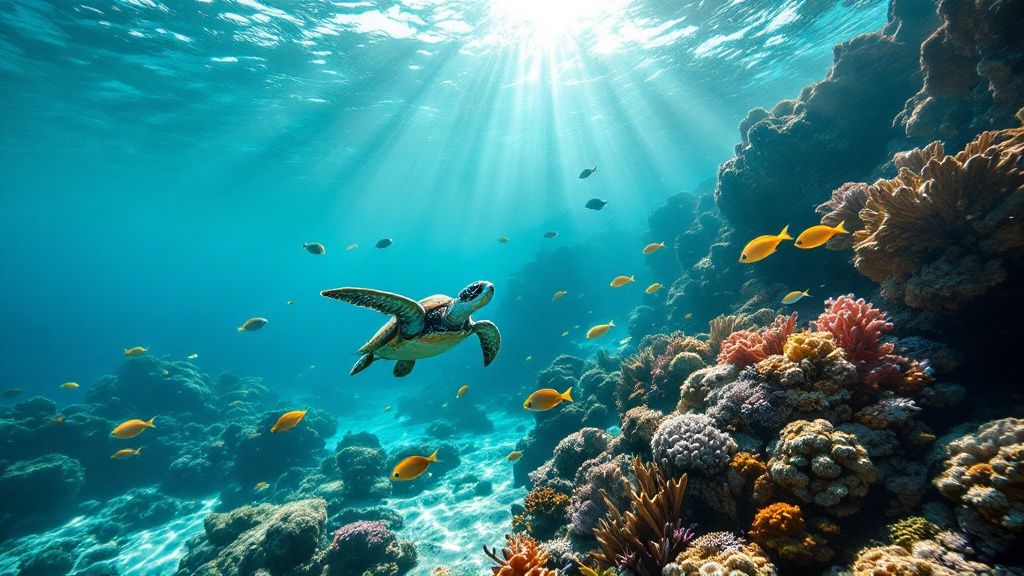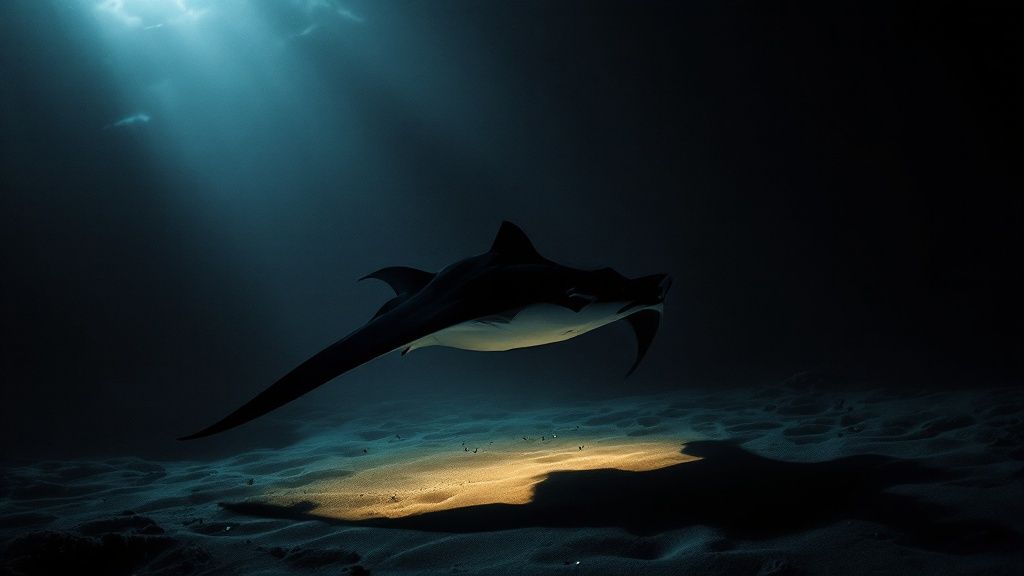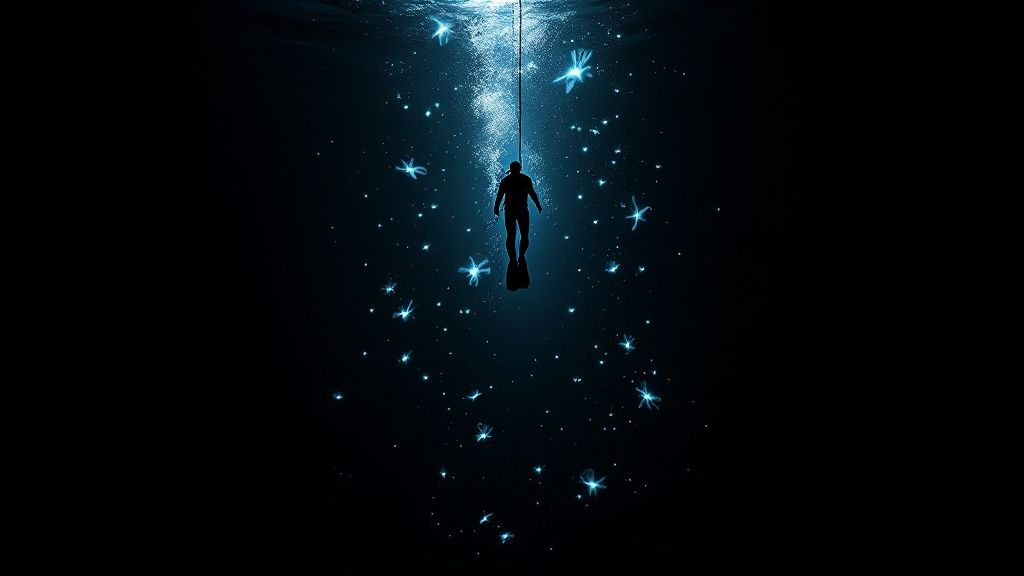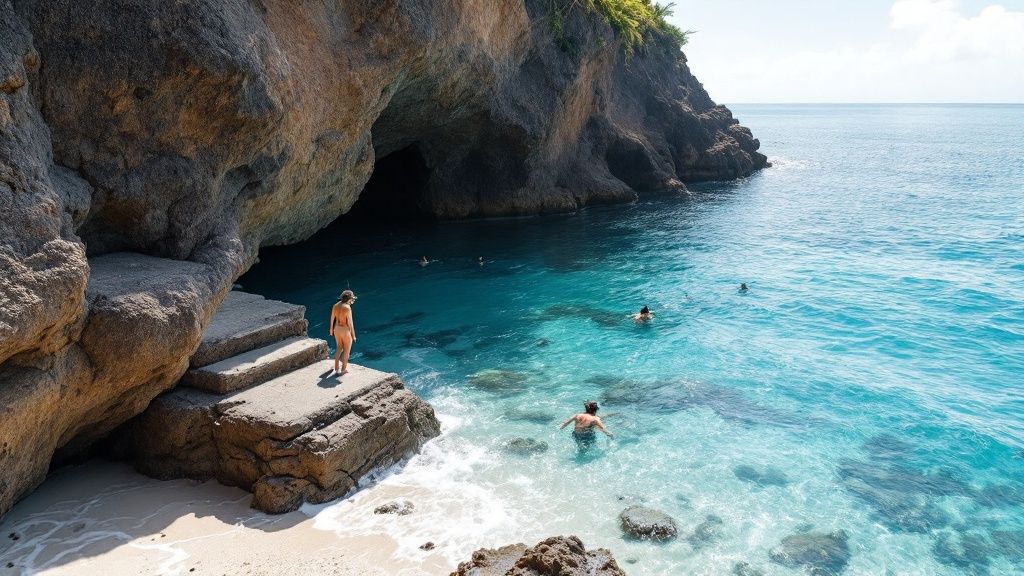Dive into Big Island Paradise
Discover six exceptional Big Island diving locations, perfect for every experience level. This list highlights top dive sites, from vibrant reefs to unique lava formations, showcasing the island's incredible marine life. Learn why these spots are essential for any Big Island diving adventure, whether you're exploring Kealakekua Bay or experiencing the thrill of a manta ray night dive. Plan your underwater exploration now!
1. Kealakekua Bay
Kealakekua Bay stands out as a premier destination for big island diving, offering an unparalleled blend of vibrant marine life, historical significance, and stunning underwater scenery. This protected marine sanctuary, located on the Kona coast of the Big Island, is renowned for its exceptional water clarity, often exceeding 100 feet, making it a dream for underwater photographers and marine life enthusiasts alike. The bay's diverse ecosystem, ranging from shallow coral gardens to dramatic drop-offs over 100 feet deep, caters to divers of all skill levels, from novice beginners to advanced explorers. Kealakekua Bay is not just a beautiful spot for diving; it's also steeped in rich history. To delve deeper into its fascinating past and vibrant marine ecosystem, check out this resource: kealakekua bay's vibrant marine life and storied past.

The bay’s unique topography creates a variety of diving experiences. The "Dropoff," for instance, is a thrilling wall dive descending into the depths, while the "Coral Gardens" offer a kaleidoscope of pristine hard coral formations teeming with colorful reef fish. Morning dives often reward divers with encounters with playful spinner dolphin pods. This rich biodiversity, featuring over 100 fish species, turtles, and occasional manta ray sightings, makes Kealakekua Bay a must-dive location for any big island diving adventure. Learn more about Kealakekua Bay.
Pros:
- Exceptional water clarity year-round
- Diverse marine life including dolphins, turtles, and a plethora of fish species
- Protection from strong currents in most areas, making it suitable for various skill levels
- Less crowded than many commercial dive sites
- Historical significance adds another layer to the diving experience
Cons:
- Requires a boat to access the prime diving areas
- Limited facilities at the site itself
- Special permits may be required for certain activities
- Can experience choppy conditions in the afternoon due to winds
- Occasional water runoff after heavy rains can temporarily affect visibility
Tips for an Optimal Dive:
- Early Bird Gets the Worm: Visit early morning for the calmest conditions and the best visibility.
- Local Expertise: Book with a local dive operator familiar with access regulations and the bay’s unique features.
- Capture the Beauty: Bring an underwater camera to document the vibrant marine life and exceptional clarity.
- Maximize Your Exploration: Consider a two-tank dive to explore different sections of the bay, like the Dropoff and the Coral Gardens.
- Respect the Reef: Maintain proper buoyancy control to avoid contact with the delicate coral formations.
Kealakekua Bay's inclusion on this list of top big island diving spots is undeniable. Its combination of historical significance, exceptional visibility, diverse marine life, and accessibility to different skill levels make it a true gem for underwater exploration. Its protected status ensures its pristine condition for generations of divers to come.
2. Manta Ray Night Dive at Garden Eel Cove
The Manta Ray Night Dive at Garden Eel Cove (also known as Manta Heaven) near Kona is a must-do experience for anyone interested in big island diving. This world-renowned site offers one of the most reliable and breathtaking opportunities to encounter manta rays up close and personal. The dive operates on a simple yet effective principle: divers kneel or sit on the ocean floor with specialized dive lights pointed upwards. These lights attract plankton, a primary food source for manta rays, drawing these gentle giants in for a spectacular feeding display. Divers are treated to an unforgettable underwater ballet as the mantas perform graceful loops and barrel rolls just inches away, feeding on the illuminated plankton.

This unique big island diving experience is characterized by its predictable manta ray encounters, making it suitable even for intermediate divers. The controlled diving environment at a depth of 30-40 feet, combined with the specialized dive protocol for manta observation, ensures a safe and rewarding experience. Divers regularly witness 6-12 mantas in a single dive, and some identified resident mantas have been observed for over 15 years. Their wingspans often exceed 12 feet, creating truly dramatic underwater encounters.
Why this dive deserves its place on the list: This dive offers a virtually guaranteed manta ray encounter, providing a unique and unforgettable interaction with these magnificent creatures. The conservation-focused approach of the dive operators ensures the long-term health and sustainability of the manta ray population.
Features and Benefits:
- Predictable manta ray encounters
- Controlled environment (30-40ft depth)
- Specialized manta observation protocol
- Night diving experience
- Conservation-focused approach
- Educational component about manta conservation
Pros:
- Nearly guaranteed manta ray sightings
- Safe, guided experience for intermediate divers
- Unique interaction with large marine life
- Accessible location near Kona airport
Cons:
- Can be crowded due to popularity
- Night diving might intimidate inexperienced divers
- Weather-dependent
- Relatively stationary dive
- Higher cost than standard dives
Tips for an optimal experience:
- Bring a good quality dive light as a backup.
- Wear gloves for a comfortable grip on the rocky bottom.
- Learn proper manta etiquette before diving (no touching, maintain position).
- Book in advance, especially during peak seasons.
- Consider snorkeling if night diving causes anxiety.
Learn more about Manta Ray Night Dive at Garden Eel Cove
This big island diving adventure has been popularized by numerous travel shows, including CNN Travel, and supported by research from the Manta Pacific Research Foundation. Local dive pioneers like Keller Laros, who established the manta identification program, and operators like Big Island Divers and Jack's Diving Locker have played a crucial role in pioneering these commercial dives, ensuring safe and sustainable interaction with these majestic creatures.
3. Black Water Night Dive
For a truly unique big island diving adventure, consider the Black Water Night Dive. This advanced, specialized experience takes you miles offshore Kona's coast into the deep ocean. Unlike typical reef dives, you'll be suspended in the pelagic zone, tethered to a downline in approximately 5,000 feet of water while floating at depths of 30-50 feet. This technique allows divers to witness the nightly vertical migration of rarely seen deep-sea creatures as they ascend towards the surface under the cover of darkness, offering a glimpse into a mysterious ecosystem that few ever witness.

This big island diving experience is like entering another world. Imagine complete darkness punctuated only by the beams of your dive light, revealing strange and wonderful larval fish, jellyfish, and cephalopods drifting in the current. Bioluminescent organisms add another layer of magic to the scene, creating an ethereal underwater lightshow. You might encounter creatures rarely, if ever, seen by humans, providing a sense of scientific discovery and the possibility of observing undocumented species. Learn more about Black Water Night Dive
This dive earns its place on this list because it offers an unparalleled opportunity to encounter unusual pelagic life. The specialized tethered diving technique and the drifting dive format following ocean currents provide a unique perspective on the open ocean ecosystem. Professional underwater photographers like Jeff Milisen and specialized operators including Pū'uhonua Ocean Explorations have popularized these dives, showcasing their otherworldly beauty in photography competitions and scientific research expeditions.
Pros:
- Opportunity to see rare and unusual marine life
- Photographic possibilities for unique deep-sea creatures
- Adventure diving at its most extreme
- Small group experience with personalized attention
- Scientific discovery aspect with possibility of observing undocumented species
Cons:
- Advanced certification required
- Higher cost than conventional dives
- Potential for seasickness during offshore boat ride
- Psychological challenge of diving in complete darkness over extreme depths
- Weather dependent with frequent cancellations
Tips for a Successful Black Water Night Dive:
- Build experience with regular night diving before attempting a black water dive.
- Bring multiple powerful dive lights with fresh batteries.
- Use a camera with good low-light capabilities and macro settings to capture the incredible sights.
- Take motion sickness medication before the boat trip to minimize discomfort.
- Follow your guide's instructions precisely for safety in this challenging environment.
This dive is ideal for adventurous scuba divers seeking a truly unique experience. It caters to those fascinated by the deep sea and its inhabitants, and offers incredible photographic opportunities. While it's not for the faint of heart, the Black Water Night Dive offers a truly unforgettable big island diving experience.
4. Two Step (Honaunau Bay)
Two Step in Honaunau Bay is a must-do for anyone interested in Big Island diving. Located adjacent to the Pu'uhonua O Hōnaunau National Historical Park (Place of Refuge), this site provides incredibly easy shore diving access combined with a rich cultural experience. Its name derives from the two-step lava rock formation that makes entering and exiting the water a breeze (under calm conditions). This protected bay boasts vibrant coral gardens teeming with life, fascinating underwater lava formations, and generally calm conditions, making it a popular spot for both novice and seasoned divers. Whether you're just beginning your underwater journey or you're a seasoned diver seeking accessible Big Island diving, Two Step offers something for everyone.

Two Step's shallow-to-moderate depths (5-60 feet) cater to a wide range of skill levels. Beginners can explore the extensive hard coral reef system in the shallower areas, while more experienced divers can venture deeper to discover lava tubes and swim-throughs. The 'Amphitheater' coral formation provides a stunning spectacle of diverse fish species. The bay's protected nature often results in calm, clear waters, ideal for underwater photography and enjoying the abundant marine life, including a resident pod of spinner dolphins and Hawaiian green sea turtles. The site's proximity to the Place of Refuge adds another dimension to the dive, allowing you to experience both natural and cultural wonders. You can even see remnants of traditional Hawaiian fishing areas from beneath the surface.
This exceptional Big Island diving location offers several advantages: no boat is required, access is free (though parking fees may apply), and it’s suitable for various skill levels. The combined cultural and natural experience truly sets this site apart. However, like any popular destination, Two Step has its drawbacks. It can become quite crowded, particularly midday, and parking can be limited. Facilities are also minimal, with no restrooms at the entry point. Furthermore, some areas of the reef are showing signs of stress from overuse, highlighting the importance of responsible diving practices. Finally, while typically easy, entry and exit can become challenging during periods of high surf.
Learn more about Two Step (Honaunau Bay)
For an optimal experience, arrive early (before 8 AM) to secure a parking spot and beat the crowds. Always use reef-safe sunscreen to protect the delicate coral ecosystem. Enter the water carefully at the designated 'two steps' and be mindful of the conditions. Consider visiting the Pu'uhonua O Hōnaunau National Historical Park before or after your dive to enrich your understanding of the area's cultural significance. Keep an eye out for the Hawaiian green sea turtles often found grazing in the shallows. Two Step’s popularity is well-deserved, featuring in Hawaii tourism campaigns, and serving as a location for reef clean-ups hosted by local conservation groups and Hawaiian cultural practitioners working to preserve the site's heritage. Two Step truly offers a memorable Big Island diving experience.
5. Pine Trees (Kohanaiki Beach Park)
Pine Trees, located at Kohanaiki Beach Park north of Kona, earns its spot on this list of top Big Island diving destinations for its unique blend of adventurous diving and lava-sculpted underwater scenery. Unlike the often-crowded southern dive sites, Pine Trees offers a more secluded experience, attracting local divers and those seeking a taste of untouched Hawaiian underwater beauty. This site gets its name from the ironwood trees lining the shore, providing a picturesque backdrop for your big island diving adventure.
This site isn't your typical coral reef dive. Volcanic activity has shaped the underwater landscape into a dramatic playground of lava tubes, formations, swim-throughs, and archways. Imagine exploring the "First Cathedral," a swim-through where sunlight filters through cracks in the ceiling, creating an ethereal underwater glow. Divers can explore sand channels that serve as cleaning stations for Hawaiian green sea turtles and, in deeper areas, may even encounter reef sharks. This diverse topography creates exciting dive profiles, appealing to divers of varying skill levels, though some experience is recommended for safe navigation, especially within the lava tubes.
Pine Trees offers big island diving opportunities across a depth range of 10-80 feet, catering to both newer and more experienced divers. A mix of sand channels and reef structures houses abundant reef fish and the occasional pelagic visitor, adding to the allure of this dive site. The multiple entry points allow for varied dive plans, further adding to the customizable experience.
Pros:
- Less crowded than southern Big Island dive sites.
- Diverse topography, offering interesting dive profiles for various skill levels.
- Abundant reef fish and occasional pelagic visitors.
- No fee for access.
- Multiple entry points catering to different dive plans.
Cons:
- Challenging shore entry over rocks necessitates careful footing and appropriate dive boots.
- Surge can be strong depending on swell conditions, requiring attention to dive planning.
- Limited facilities at the beach park.
- Requires some experience for safe navigation, especially within the lava tubes.
- Visibility can be reduced after rain.
Tips for Diving at Pine Trees:
- Wear booties: The rocky shore entry requires sturdy dive booties to protect your feet. Use caution during entry and exit.
- Check the surf forecast: Conditions can change rapidly. Avoid diving during high surf or strong surge.
- North Cove Entry: During higher surf, enter through the cove on the north end for a calmer entry.
- Surface Marker Buoy: Bring a surface marker buoy, especially if diving near boat traffic areas.
- Consider a Guide: For your first dive, especially if exploring the lava tubes, consider using a local guide familiar with the site's intricacies.
Pine Trees has been popularized by local dive clubs, Big Island residents, and is often featured in advanced diving guidebooks. Underwater photographers are particularly drawn to the unique lava formations, creating stunning imagery of this underwater volcanic world. Whether you’re an experienced diver seeking adventure or a novice looking for a unique big island diving experience, Pine Trees offers an unforgettable dive into Hawaii's volcanic heart.
6. The Caverns (South Kona Coast)
For big island diving enthusiasts seeking a truly unique underwater adventure, The Caverns off the South Kona coast is a must-dive. This boat-accessible site offers an otherworldly experience exploring Hawaii's volcanic origins through an intricate network of lava tubes, caves, and caverns. This dive site stands out among other big island diving locations because of its unique geological formations and the diverse marine life that inhabits these protected spaces. Learn more about The Caverns (South Kona Coast)
The Caverns showcases the dramatic effects of volcanic activity on the underwater landscape. Divers can navigate through a complex lava tube system, exploring multiple interconnected caverns and swim-throughs. Natural light filters through openings in the lava rock, creating spectacular light beams and illuminating the dramatic vertical lava formations. The site offers a compelling mix of open reef and enclosed spaces, catering to a sense of adventure and discovery. Depths range from 30-80 feet, making it suitable for intermediate to advanced divers comfortable with overhead environments.
Features:
- Complex lava tube system
- Multiple interconnected caverns and swim-throughs
- Natural light effects through lava rock openings
- Dramatic vertical lava formations
- Mix of open reef and enclosed spaces
Examples of key features within The Caverns:
- The 'Skylight Cavern': A large cavern with a ceiling opening that creates spectacular light rays, providing fantastic photographic opportunities.
- The 'Maze': A section with interconnecting passages that challenges divers' navigation skills (always stay with your guide!).
- The 'Shark Shelter': An area where white tip reef sharks often rest, providing a thrilling encounter for divers.
Pros:
- Unique geological diving experience
- Protection from currents inside caverns
- Diverse marine life including resident white tip reef sharks
- Photographic opportunities with light beams
- Less affected by weather than exposed sites
Cons:
- Boat access only
- Requires good buoyancy control and spatial awareness
- Some overhead environments require proper training (consider a specialized cavern diving course)
- Limited visibility can occur with surge
- Moderate depth requires proper air management
Tips for Diving The Caverns:
- Bring a good quality dive light even during daytime dives to enhance visibility within the caverns.
- Review overhead environment diving techniques before visiting, especially if you haven't dived similar sites recently.
- Follow your guide's route carefully to avoid damaging the fragile formations and to ensure safe navigation.
- Consider taking a specialized cavern diving course to gain further confidence and skills for exploring overhead environments.
- Maintain contact with your buddy throughout the dive, especially within the enclosed spaces of the caverns.
The Caverns has gained popularity among Kona dive operators specializing in advanced experiences and underwater geology researchers. It's even featured in dive training materials for specialty courses. This unique big island diving destination offers an unforgettable experience for adventurous divers seeking to explore the dramatic underwater volcanic landscapes of Hawaii.
Big Island Diving Sites Comparison
| Diving Spot / Experience | 🔄 Implementation Complexity | 🛠️ Resource Requirements | 📊 Expected Outcomes | 🎯 Ideal Use Cases | ⚡ Key Advantages | 💡 Tips & Insights |
|---|---|---|---|---|---|---|
| Kealakekua Bay | Moderate: Boat required, permit for some activities | Boat access, snorkel/diving gear, permit | Exceptional coral reef ecosystem, high visibility | Varied skill levels, marine life encounters | Pristine reefs, calm protected waters, diverse marine life | Early morning visits, book local operator, buoyancy control |
| Manta Ray Night Dive at Garden Eel Cove | Moderate: Night diving protocols, guided | Dive lights, night diving certification, guide | Near-guaranteed manta encounters, unique night scenes | Intermediate divers seeking close manta interaction | Reliable manta sightings, educational, accessible from Kona | Bring backup lights, learn manta etiquette, book early |
| Black Water Night Dive | High: Advanced certification, deep ocean, tethered | Advanced gear, multiple dive lights, boat ride | Rare deep-sea species, pelagic encounters, unique photos | Experienced night divers, scientific & adventure purposes | Exclusive rare species viewing, intimate small groups | Build night dive experience, carry extra batteries, follow guides strictly |
| Two Step (Honaunau Bay) | Low: Shore entry, minimal logistics | Basic diving/snorkeling gear | Accessible coral gardens, cultural and natural sites | Beginners to advanced divers, shore diving | Easy access, cultural richness, resident dolphins | Arrive early, use reef-safe sunscreen, respect entry conditions |
| Pine Trees (Kohanaiki Beach Park) | Moderate: Challenging shore entry, variable currents | Shore gear, experience recommended | Dramatic lava formations, diverse marine life | Adventurous divers avoiding crowds | Less crowded, interesting topography | Wear booties, check surf forecast, consider guide |
| The Caverns (South Kona Coast) | High: Boat access, overhead environment training | Boat, dive lights, advanced skills | Volcanic lava tubes, swim-throughs, dramatic geology | Intermediate to advanced divers, cavern enthusiasts | Unique geological features, protected from currents | Use quality lights, review overhead diving techniques, maintain buddy contact |
Planning Your Big Island Diving Adventure
From the vibrant coral gardens of Kealakekua Bay to the mesmerizing manta ray ballet at Garden Eel Cove, big island diving offers an unparalleled underwater experience. Whether you're captivated by the unique black water night dive, exploring the lava formations of The Caverns, or enjoying the easy access of Two Step and Pine Trees, the Big Island's diverse dive sites cater to every skill level, from novice to seasoned pro. Mastering the nuances of each site, understanding the conditions, and choosing the right dive operator will maximize your enjoyment and ensure a safe and memorable adventure. These considerations are crucial for experiencing the full spectrum of marine life and geological wonders that lie beneath the surface, creating memories that will last a lifetime. The Big Island awaits – are you ready to explore its hidden depths?
Ready to dive into the Big Island's incredible underwater world? Kona Honu Divers offers exceptional guided dives and personalized tours to many of the sites mentioned, ensuring an unforgettable big island diving experience. Visit Kona Honu Divers to book your next adventure and discover the magic of the Pacific.
